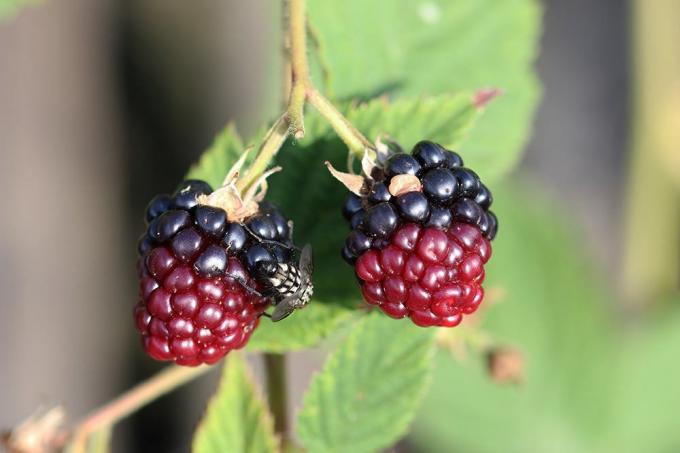
table of contents
- When to harvest blackberries
- Instructions: harvest properly
- Factors Affecting the Harvest
The blackberries (Rubus fruticosus) belonging to the rose family (Rosaceae) are sweet and tart and have a juicy taste. They are mainly used in fruity cakes, jams, juices and sauces. They are also very popular as sweets straight from the bush during the most beautiful season in summer. The harvest time of blackberries takes place continuously over a relatively long period of time. Everything you should know about the right time to harvest can be found below.
Unlike with fruits such as apples, plums or peaches, the harvest time of the blackberries extends beyond several months into autumn, as not all berries on a shrub are ripe at the same time will. Sometimes there are only berries ripe for picking on individual tendrils and the fruits are formed later on other shoots. The shrub can therefore not be harvested completely. As a rule, you can harvest blackberries in your own garden, but also wild fruits continuously from July to October, with the main season being in the months
August to September lies. There should be no more harvest after the first frost. The fruits then have a rather bland taste. They then serve as a good source of food for native birds.Tip: Blackberries contain many vitamins and minerals. 100 grams of these juicy fruits can cover a third of the daily vitamin C requirement and strengthen the immune system.
When to harvest blackberries
During the harvest time it is advisable to pick the ripe fruits from the bush at least once or twice a week so that they do not spoil. This also ensures that the fruits remaining on the blackberry bush receive more sun and light in order to reach maturity. If possible, the harvest should take place on a sunny morning. After prolonged rain, you should not pick the berries. These then have a watery taste. However, the question now arises, when exactly are blackberries ripe? At first the fruits are green, then turn pink to red, until they finally ...

- plump, strong black and shiny
- Fruits are juicy, sweet to tart
- are easy to pick
- Leaf crown comes off easily

In this case it is high time to harvest. If there are any doubts about the degree of ripeness of the fruit, a taste can be helpful. It is important that only ripe fruits should be harvested, as blackberries do not ripen. Unripe berries are not only recognizable by their sour taste, they are green or light red, inedible and should remain on the bush for some time. If such fruits are consumed, stomach pain can occur.
Sometimes the berries can stay red and do not ripen any further. The whole berry can be affected or just one area. Usually only individual fruits on the bush are affected. The reason for this is the presence of the blackberry mite (Acalitus essigi). It can hardly be seen with the naked eye and sucks the berries in. This affects the ripening process. Most of the time the fruits stay red, are unripe and just as inedible.
Tip: To prevent the infestation, normal rapeseed oil can be mixed with a little water to form a sprayable liquid. To do this, the fresh shoots are sprayed shortly after budding and a repetition takes place shortly before full bloom.
Instructions: harvest properly
Since most blackberry bushes, with the exception of a few new varieties, have spines, appropriate equipment is necessary:
- gloves
- long trousers
- long tops
- solid shoes
- small baskets
The fruits must not be crushed and should be stored loosely and carefully in the containers.

Dried, moldy or mushy fruits should also be removed from the bush regularly to prevent infections. The harvested branches die off after the harvest and can then be cut off close to the ground. This will make the further harvest easier.
Tip: Blackberries should be consumed fresh whenever possible. They keep in the refrigerator for a day or two. They are also ideal for freezing and making juices, jams and jellies.
Factors Affecting the Harvest
With the varieties grown in this country, it is rare to discover a difference in the ripening period. However, the time for harvest is not always that easy to determine, as fruit formation takes place differently on the individual tendrils after the flowering period. This means that the berries ripen after a few days. The ripening of the fruits depends on various factors:
- weather
- Location
- regular pruning
- adequate fertilization and watering

In a full sun, the blackberries ripen more evenly, earlier and are far more aromatic than berries that grow in the shade. Care with regard to pruning, fertilization and watering also influence the ripening time, the aroma and the size of the berries. Sometimes it can quickly happen that after a prolonged period of damp weather, the fruits go moldy directly on the bush. These must be removed as quickly as possible. Furthermore, tendrils without flowers should be cut away so that the shrub can put the energy into the existing fruits. The annual shoots should also be cut by half in autumn.
Tip: By planting different varieties, a different variety of tastes is possible for the fruits. This means that the harvest time can also be extended or brought forward.



